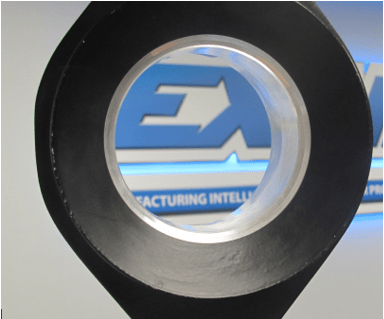
Many times we get the question, “What’s the difference between a fan and an Air Amplifier?”. The best way to answer is to do a comparison. EXAIR Super Air Amplifiers and electrical fans are both designed to move air. Fans use motors and blades to push the air toward the target. There are mainly two types, centrifugal fans and axial fans. The air enters from directly behind the fan, and the blades “slap” the air forward to the target. This creates turbulent and loud air noise that may or may not actually impact the target. The EXAIR Super Air Amplifiers do not use any blades or motors to push the air. They use a Coanda profile with a patented shim, allowing compressed air to escape in such a way that a low pressure area is created to draw in surrounding, ambient air. (You can read more about it here: Intelligent Compressed Air: Utilization of the Coanda Effect.) So, they create laminar (non-turbulent) output flow, which is much quieter and has the same direction and velocity, making it more effective to move heat energy out of or into a target, depending on your application goals. Side note: EXAIR Air Amplifiers can be used in high temperature ambient conditions right out of the box. Fans by comparison, generally cannot be used unless they are specifically designed for the purpose.
In one example application, a customer contacted EXAIR to find a better way to cool a die in a rotational molding facility. Rotational molding, or Roto molding, involves a heated hollow mold that is filled with plastic material. It is then slowly rotated (usually around two perpendicular axes), causing the softened material to disperse and cling to the walls of the mold. In order to maintain an even thickness throughout the part, the mold has to continue to rotate during the heating phase. After the desired timing sequence, the heating is turned off to allow the material to solidify.
This particular company was making plastic containers. To try and improve the cycle rate between each container, they were using two fans (reference photo below) for cooling. Time is money in this industry, and they wanted to target the fans to improve cooling. Water has a higher specific heat, but using water for cooling would affect the life of the molds due to thermal shock. Cooling with air was their only option. EXAIR had a solution for them: the Super Air Amplifier.

The Super Air Amplifier, when compared to fans, are compact, easy to use, and very effective in cooling. The capacity to cool is determined by the mass of air and the temperature difference. Since the mold is heated to 650oF (343oC) and the ambient air is 80oF (27oC), we have a good temperature difference for cooling. For this application, I recommended replacing their fans with our model 120024 4” Super Air Amplifiers. Each one can move 2,190 SCFM (6,1977 SLPM) of air while only using 29.2 SCFM (826 SLPM) of compressed air at 80 PSIG (5.5 Bar). With the combination, we were able to cool the mold 25% faster than the fans. EXAIR did a comparison video between a Super Air Amplifier and a fan for cooling. Watch it HERE.
In physics, it is easier to pull than it is to push. The same goes for moving air. Fans are designed to “push” the air, while the Super Air Amplifiers are designed to “pull” the air. This method of pulling makes it simple to create a laminar flow in a small package that is more efficient, effective, and quiet. With the patented shims inside the Super Air Amplifier, they maximize the amplification by “pulling” in large amounts of ambient air while using less compressed air. More air mass means better cooling. And no moving parts in an Air Amplifier means no maintenance. If you want to move away from blower systems or axial fan systems to get better cooling, drying, cleaning, and conveying, you can contact an Application Engineer for more details about our Super Air Amplifiers.
John Ball
Application Engineer
Email: johnball@exair.com
Twitter: @EXAIR_jb